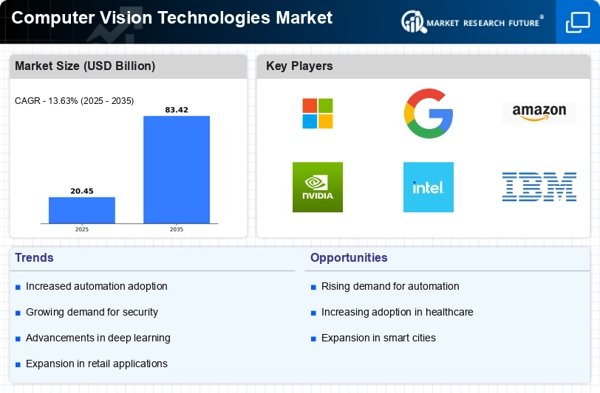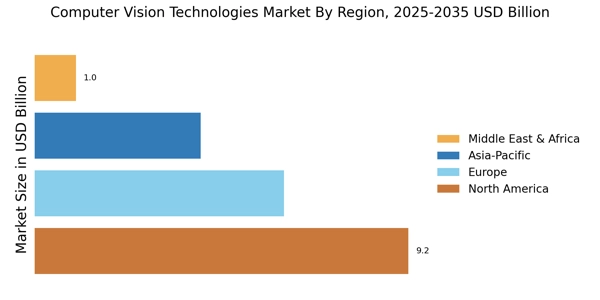The Computer Vision Technologies Market is currently characterized by a dynamic competitive landscape, driven by rapid advancements in artificial intelligence and machine learning. Key players such as Microsoft (US), Google (US), and NVIDIA (US) are at the forefront, leveraging their technological prowess to enhance product offerings and expand market reach. Microsoft (US) has been focusing on integrating computer vision capabilities into its Azure cloud services, thereby positioning itself as a leader in providing scalable solutions for enterprises. Meanwhile, Google (US) continues to innovate with its TensorFlow platform, which facilitates the development of machine learning models, thus enhancing its competitive edge. NVIDIA (US), known for its graphics processing units, is increasingly investing in AI-driven computer vision applications, particularly in sectors like automotive and healthcare, which further shapes the competitive environment.
The market structure appears moderately fragmented, with a mix of established players and emerging startups. Key business tactics such as localizing manufacturing and optimizing supply chains are becoming increasingly vital for companies aiming to enhance operational efficiency. For instance, many firms are now focusing on regional partnerships to streamline their supply chains and reduce costs. This collective influence of major players not only intensifies competition but also fosters innovation, as companies strive to differentiate themselves in a crowded marketplace.
In August 2025, Google (US) announced a strategic partnership with a leading automotive manufacturer to develop advanced driver-assistance systems utilizing its computer vision technology. This collaboration is significant as it underscores Google's commitment to expanding its footprint in the automotive sector, where computer vision plays a crucial role in enhancing safety and efficiency. Such partnerships may also facilitate the integration of AI technologies into traditional industries, thereby driving further adoption of computer vision solutions.
In September 2025, NVIDIA (US) unveiled a new suite of AI-powered tools designed for healthcare applications, particularly in medical imaging. This launch is indicative of NVIDIA's strategy to penetrate the healthcare market, which is increasingly reliant on computer vision for diagnostics and treatment planning. By focusing on this sector, NVIDIA not only diversifies its portfolio but also positions itself as a key player in a rapidly growing market segment.
In October 2025, Microsoft (US) expanded its computer vision capabilities by acquiring a startup specializing in facial recognition technology. This acquisition is likely to enhance Microsoft's existing offerings and provide a competitive advantage in sectors such as security and retail. The move reflects a broader trend where established companies are acquiring innovative startups to bolster their technological capabilities and maintain market leadership.
As of October 2025, the competitive trends in the Computer Vision Technologies Market are increasingly defined by digitalization, sustainability, and the integration of AI. Strategic alliances are becoming pivotal, as companies recognize the need to collaborate to harness the full potential of computer vision technologies. Looking ahead, competitive differentiation is expected to evolve, shifting from price-based competition to a focus on innovation, technological advancement, and supply chain reliability. This transition may ultimately redefine the competitive landscape, as companies that prioritize these elements are likely to emerge as leaders in the market.

















Leave a Comment